Once, there was a kite who loved to fly.
Each day, it soared high above fields and rooftops, dipping and dancing in the wind. Children below marvelled at the bright colours, its grace and joy.
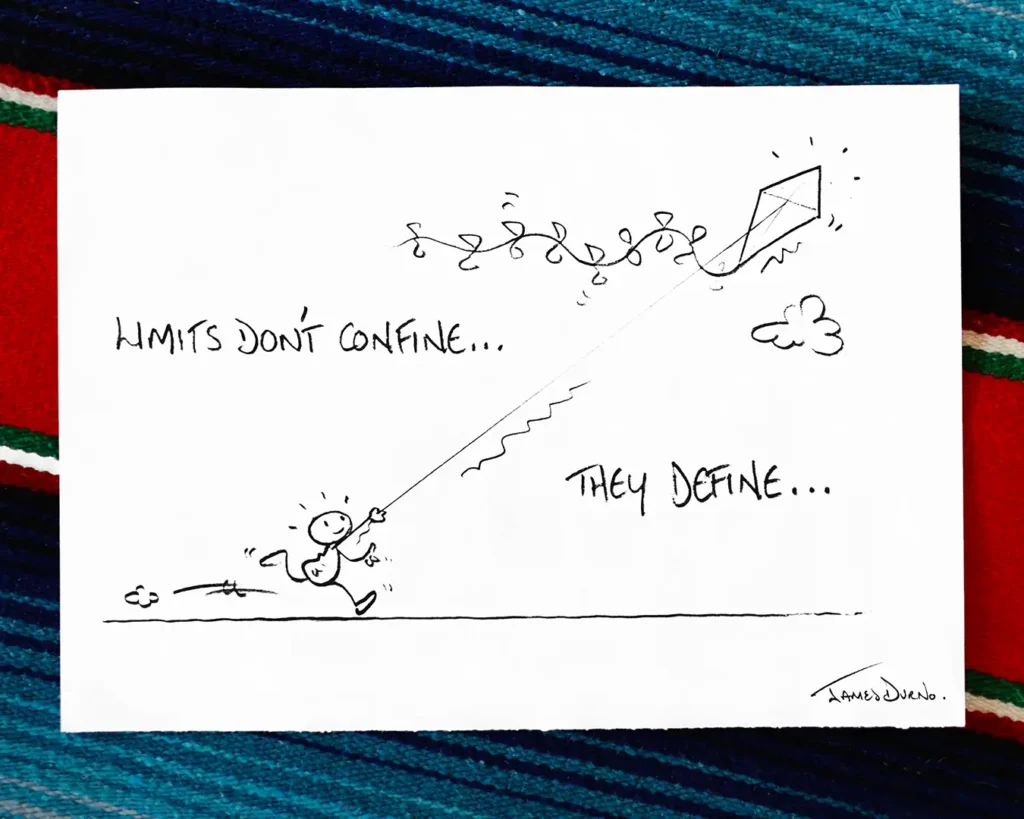
But… as the kite twisted and turned through the boundless, beautiful, big, blue sky, it began to resent the string that held it.
"If only I were free," thought the kite, "I could go anywhere I wanted. I could fly higher than ever before, without anyone holding me back."
The string tugged gently, a steady, guiding tension. But the kite saw it as a chain.
One day, catching a powerful gust, the kite strained with all its might and SNAPPED the string!
For a moment, it was exhilarating. The kite soared, wild and weightless. "At last, I’m truly free!" it cried.
But then the wind shifted…
Without the string to steady it, the kite was directionless. The breeze, once a playful partner, had become a raging gale. The kite, now lost and helpless, was tossed and tumbled like a leaf.
And finally, it fell, caught in the branches of a tree. Tangled and torn.
Then, the kite understood.
It was the string that had given it flight. That limiting tether it so resented was its lifeline: the very thing that gave it the freedom to dance with the wind.
Freedom without boundaries is not freedom at all.
Limits don’t always confine. Sometimes they define.
We often think of freedom as the absence of boundaries, the unshackled self, soaring unimpeded through wide, open skies. But true freedom is rarely found in boundlessness. It is not the absence of constraints, but the presence of purpose, of discipline, of something to tether us.
Imagine a kite, high above the earth, riding the sky.
From the ground, it appears free: gliding, climbing, swooping with effortless grace. But the secret to its flight is not the wind alone. It is the string. That taut line connecting it to the earth is also what allows the kite to soar.
The string provides the tension between freedom and control, guidance and direction.
The kite may strain against it, feel it as a limitation, even dream of cutting free in pursuit of perceived freedom… one without rules and accountability.
But the moment the string is cut, it is the end of freedom. The wind, once a partner in play, becomes a chaotic force of destruction.
The string was never the enemy, but the very thing that made flight possible.
In life, like in flight, freedom and constraint are not opposing forces. They work in tandem. Constraints provide the parameters for creativity. Discipline sharpens potential. And accountability gives our actions meaning.
We live in a world that romanticises, even glamourises, spontaneity and rebellion. We are encouraged to break free, to live unbound, to follow only our desires, to cast off restraint.
But a life without boundaries becomes a life without form. We run the risk of disorientation, chaos, and the slow erosion of purpose.
Limits don’t always confine. Sometimes they define…
In the 1964 movie, Mary Poppins, to the children’s delight and amazement, pulls a series of impossibly large items – a standard lamp, a potted plant and a coat stand - from her carpet bag…
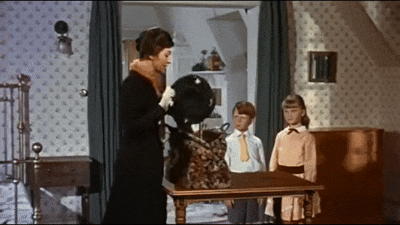
I first saw the movie ten years later, in 1974, when I was just six years old. Fast-forward a few decades, and I am now a grown-up Visual Communicator. Which means I’m an Artist, Graphic Recorder and Business Illustrator. My task is to make the complex simple by collapsing ideas into simple and accessible visuals.
But simple isn’t easy.
Which brings me to my point.
What is the value of a picture?
A picture doesn’t simply unpack an idea – in fact, it does quite the opposite. A well-crafted visual packs ideas for the unpacking.
Like Mary Poppins’ Carpet Bag, a powerful visual can hold ideas that are much bigger than the picture itself. It too is paradoxically bigger on the inside than it is on the outside.
A strong visual captures, synthesises, sorts, sifts, collapses, “zip-files” and succinctly communicates. It distils, compresses, organises, clarifies and simplifies complexity. It speaks powerfully, even eloquently.
Whatever the visual process or visual device, whether it be a visual metaphor, design thinking, rich picture, drawing, painting, visual narrative, mind map, roadmap, graphic recording, or sketchnote – Pictures communicate. Powerfully.
A Drawing holds and carries meaning. It is a bespoke container, crafted to carry an idea. In many respects, it is the proverbial box reimagined.
The process of simplification, collapsing and distillation does not reduce quality and potency. On the contrary. The process of simplification creates a powerful concentrate, and gravity and potency are multiplied.
So, what is the value of a picture?...
Perhaps we should be asking, “what is the value of a clearly articulated Vision. Or a well-communicated Strategy?”
This is the Power of Visual communication. This is the Power of Visual Thinking.
Why, it’s Supercalifragilisticexpialidocious!
Recently, I had the great pleasure of hosting a Cape Town CEO at my studio for a one-on-one Visual Conversation.
We started with a Brain Dump on a large whiteboard. A perfect erasable medium for a shifting and organic conversation.
We then moved to working with paper cutouts on my V3 Neuland Graphic Wall. Instead of post-its, we worked with multiple photocopied “platforms” drawn in oblique perspective.
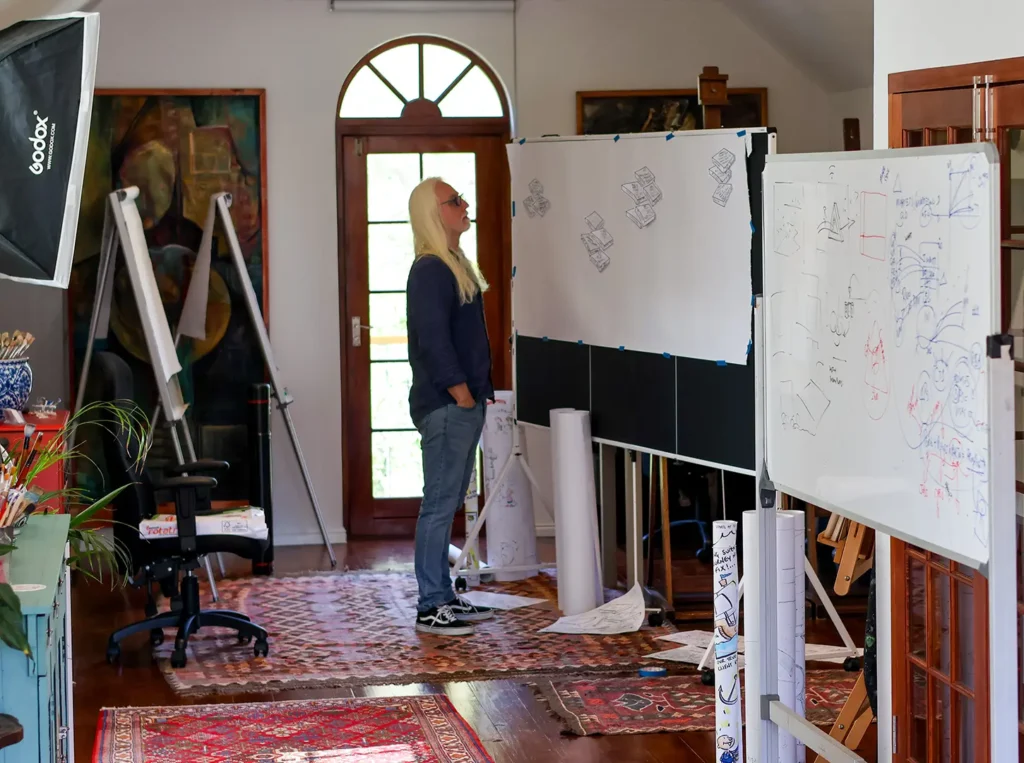
Because they are drawn in perspective, and have a top and sides, I can add a title or descriptor to the side edges. The surface plane can hold the content or the idea. The perspective also breaks the picture plane and gives one a sense of working in navigable space.
We were able to break down the complexity of the content, identify the component parts, group and assemble (and reassemble) relative to each other.
I drew very little, and most of my visual notes were drawn separately on another surface.
After a couple of hours, we had broken through the noise and clutter.
We can now begin to visualise, populate and illustrate the detail...
A Visual Conversation takes place in the space between us.
It is quite literally “getting on the same page.” It is collaborative and co-creative.
It is pushing and pulling, diverging and converging, breaking apart and reassembling, pulling back and zooming in, to reach simplicity, clarity and consensus.
This is the value of a Visual Conversation. This is the Power of Visual Thinking.
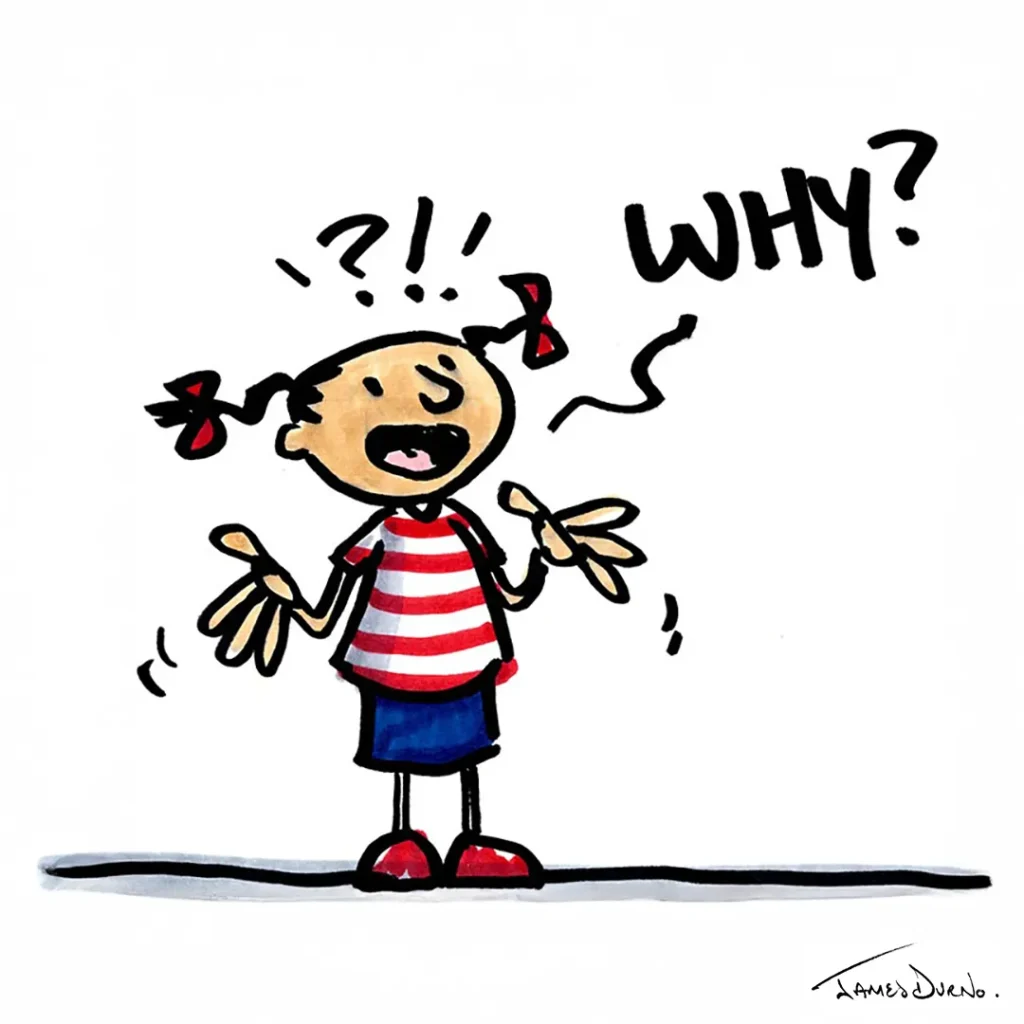
The greatest innovators are those who don’t just think outside the box - they question why the box exists at all.
And sometimes, reimagining the box is just the genius of not knowing what’s impossible…
Intelligent naïveté is wonder wearing spectacles. It is a blend of childlike curiosity and informed
awareness. It’s the ability to question assumptions, see with fresh eyes, and explore ideas without being limited by the way things have always been done, whilst still drawing on experience and critical thinking. It has the audacity to imagine better while carrying the weight of experience lightly.
Why is it done this way?... What if we tried something different?... Why not?...
It is one thing that artists, scientists, entrepreneurs, and children have in common - the audacity to ask questions that no one else is asking.
It is purposeful curiosity and an open, unconditioned perspective.
A willingness to suspend disbelief long enough to explore better possibilities.
It is the “what if?” that sets stagnant waters rippling.
Intelligent Naivete challenges norms… Sees possibility… Finds doorways in walls others walk past… It dares to wonder…
Breakthroughs belong to those wise enough to learn — and naïve enough to question…
Let’s not grow so wise that we forget how to wonder.
So…What is your Why?..
AI promises speed and simplicity - but in outsourcing thinking, creativity, and visual communication to algorithms, we risk losing the human nuance behind meaning-making. Like a high-interest credit card, the convenience comes with a hidden cost: loss of expertise, ethical erosion, and the atrophy of true creative practice.
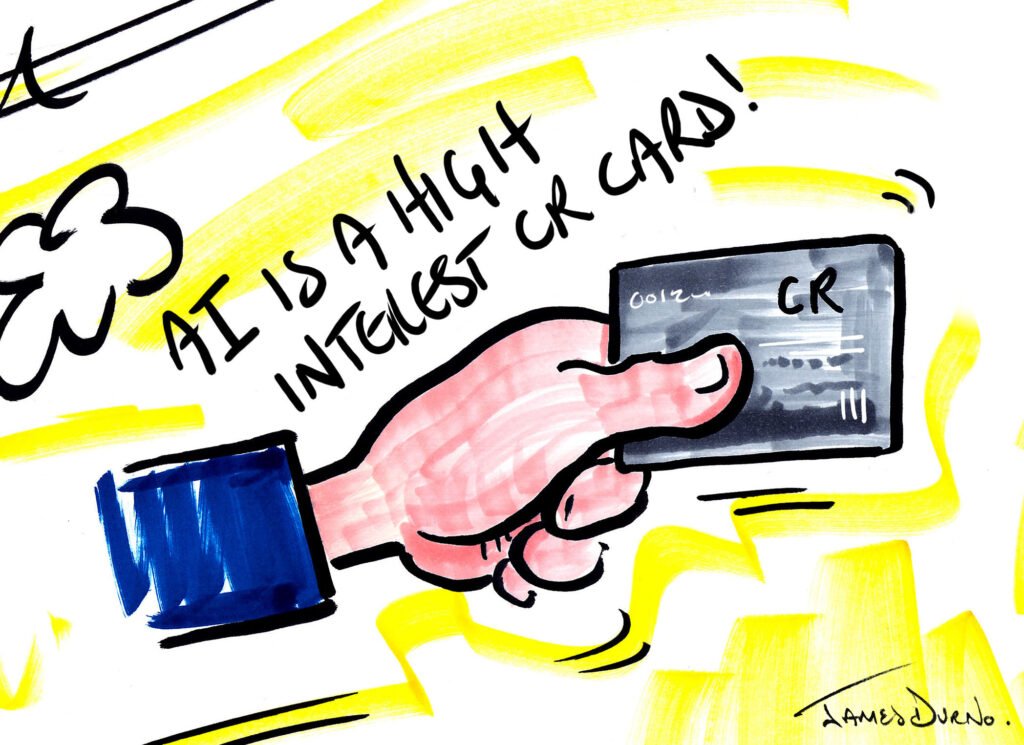
AI is mind-blowing. When I studied fine art back in the 80s, the idea that a machine could generate a credible artwork, mimic a voice, or eloquently write on demand would have felt like pure science fiction. The possibilities AI unlocks seemingly endless.
However…
AI is like a High Interest Credit Card, and it seems we are swiping faster and faster, with reckless abandon…
… Generating content, automating our decisions, offloading tasks… outsourcing our thinking and creativity for the sake of speed and efficiency…
AI offers speed, ease, and tempting shortcuts, but the cost is quietly compounding, and the interest is high… There will be consequences…
As we outsource thinking, creativity, and judgment, we risk forgetting how to think, create, and discern for ourselves...
It feels like we are building an over-reliance on opaque systems we do not understand…
Fragile foundations - we prioritise quick wins over structural integrity... and that’s how cracks form - slowly at first, then all at once…
We allow algorithms to decide for us without questioning the assumptions or source. There is an ethical erosion as we mine the thought leadership of others and present it as our own expertise...
Like using credit to fund a lifestyle we can’t afford, AI simulates progress without us having to do the vital foundational work.
Interest accrues in the form of bias, skills stagnation, trust erosion and creative atrophy…
And eventually there will be a price to pay…
Obviously, I have a creative industries bias, as a Visual Communicator, Graphic Recorder and Artist, but ultimately there isn’t an industry that won’t be impacted by AI.
I’m not for a moment suggesting that we shouldn’t use AI, just that we use it wisely, thoughtfully and with our eyes wide open.
So, what are we borrowing against?
What are we surrendering for the sake of convenience?
And who will ultimately pay… and at what cost?...